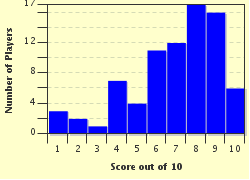Quiz Answer Key and Fun Facts
1. A little honey loving insect + A word that almost sounds like a place that grows fruit trees
2. A hot season of the year + A beautiful multi-shaped drop from the sky in wintry weather
3. A little animal often hunted by people on horses, accompanied by baying hounds + A covering for the hand in colder weather or at balls
4. Esau's twin + Add a young boy to the front of the 4th, 5th and 18th letters of the alphabet in that order. Your answer is the second word in this two-word plant only.
5. Very proper and correct + Stood up
6. Take the definite article and remove the vowel + The transportation along the Mississippi used by Huckleberry Finn, but replace its vowel with an "I"
7. It goes "Moo!" + Fall over or another word for a petticoat
8. The name of a famous cheese + A delicate colour between white and red
9. One of an identical set of children + Another word for a bloom
10. A floating white rain-giving drift in the sky + A small round edible fruit
Source: Author
Creedy
This quiz was reviewed by FunTrivia editor
Fifiona81 before going online.
Any errors found in FunTrivia content are routinely corrected through our feedback system.
